Essential workers must reapply for permits as coronavirus sewage tests rolled out
Essential workers across Melbourne will soon be forced to reapply for their work permits as the city’s crippling lockdown extension comes into effect. It comes as a website inviting doctors to sign an open letter to Daniel Andrews protesting against Victoria’s extended lockdown has been shutdown.
Coronavirus
Don't miss out on the headlines from Coronavirus. Followed categories will be added to My News.
This coronavirus article is unlocked and free to read in the interest of community health and safety. Get full digital access to trusted news from the Herald Sun and Leader for just $1 a week for the first 12 weeks.
Essential workers across Melbourne will soon be forced to reapply for their work permits if the documents expire over the next month.
Premier Daniel Andrews said employers would be able to use the same documents to quickly repeat their last applications with new dates.
“We have tried to reduce the administrative burden as much as possible but if those permits are going to be accurate and effective, particularly for the purposes of curfew, they do need to be reissued,” he said.
Government staff processing those affected will prioritise applications to ensure no one is left without a permit while they should be working.
Childcare permits are not dated and will remain valid under current restrictions.
The need for documents was initially instated at the start of stage four lockdown and the permits’ extension comes as the restrictions are now set to extend beyond September 13.
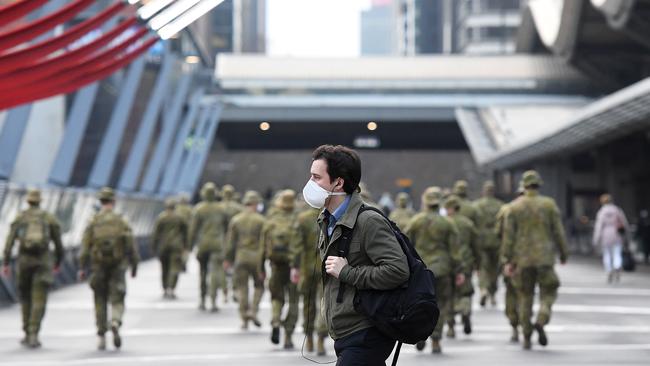
DOCTORS THREATENED OVER LOCKDOWN LETTER
A website inviting doctors to add their names to an open letter to Daniel Andrews protesting against Victoria’s extended lockdown has been shutdown.
The website had attracted more than 600 signatures of support from doctors around the state, but was closed for security reasons.
The Herald Sun understands some doctors who had signed the letter had received hate mail, and a decision was made to temporarily close the site.
But Box Hill Hospital urologist Dr Geoff Wells said he expected the site to be up and running again soon.
Dr Wells said he was yet to receive a response to the letter, but understood the Premier was a busy man.
But he said he was holding out hope that his invitation to meet with policy makers about the lockdown extension would be taken up so he and a team of medical professionals could outline a common sense approach to the pandemic response.
Dr Wells said the lockdown was doing more harm than coronavirus.
“We need to sit down and discuss this, the future of the state relies on this. I think there’s been a significant shift in public opinion on this,” Dr Wells said.
The letter, originally signed by 13 senior medical practitioners, outlined their concerns about the State Government’s response to the COVID-19 pandemic.
They say it is “vital” stage four restrictions are lifted on September 13, believe “an alternative medical response” is required and highlight key data they think is being “excluded”.
In the letter the doctors wrote: “It is our professional opinion that the stage 4 lockdown policy has caused unprecedented negative economic and social outcomes in people, which in themselves are having negative health outcomes.”
After the letter was published online it attracted more than 600 signautres from medical professionals.
“The response has been overwhelming,” Dr Wells said.
Dr Wells said a team of doctors was on standby to meet with the Premier or government representatives at short notice.
NEW CASES SPIKE AS 11 MORE VICTORIANS DIE
Victoria saw a spike in coronavirus cases for the second day in a row, with 76 new infections recorded.
Eleven deaths were also recorded overnight with nine linked to aged-care.
It comes after 41 cases were diagnosed on Monday, followed by 55 on Tuesday.
The state has now recorded 19,688 cases in total and 694 deaths.
Victoria’s latest victims include a woman in her 60s, three women and two men in their 80s and three women and two men in their 90s.
Currently, 196 Victorians are in hospital, with 20 receiving intensive care and 12 on a ventilator.
There are 829 aged-care active cases and 252 cases across healthcare workers.
The state now has 1622 active cases, including 82 in regional Victoria — seven of which are new.
Colac has 30 active cases, five new.
Greater Geelong has 15 active cases, one new.
Greater Bendigo has just two active cases and no new cases and Ballarat where there are no active cases.
Melbourne’s 14-day rolling average is 74.5 and the regional Victorian rolling average is five cases, with an 80.8 average across both regional and metro Melbourne.
Waste water is being sampled in 25 locations across the state to see if there are changes in the level of coronavirus present after the virus was detected in Apollo Bay’s sewerage system.
According to Nick Crosby from Melbourne Water, the method is aimed to provide data for around 70 per cent of Victoria’s population.
“Many people who are infected will excrete in their stool. It can also be washed off their hands or if they’re using tissues, they might discard them in the toilet,” he said.
“If there is one person in a catchment, then the sewerage makes its way to the treatment plant and then you have to sample it at a certain time to detect that.”
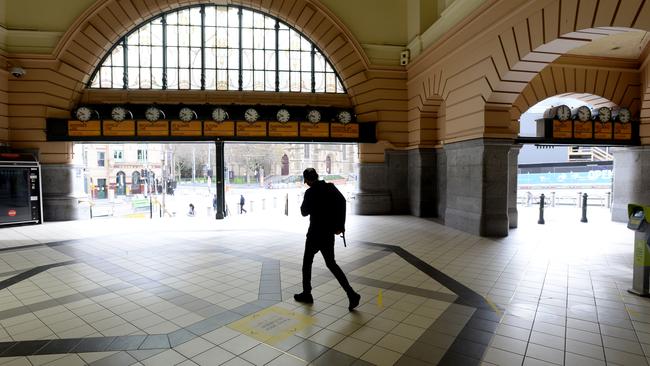
ANTI-MASK KAREN REFUSES TO WEAR THREE MASKS
An anti-mask Karen has been fined after failing three opportunities to comply with Victoria’s compulsory mask in public law.
The woman was at Broadmeadows train station in Melbourne’s outer north when police spotted her not wearing a face covering.
Police said she was given three face masks by officers but refused to wear any of them and was slapped with a $200 fine for her troubles.
The woman was among 140 Victorians fined in the past 24 hours for breaching the chief health officer’s restrictions, with 20 others also handed infringements for failing to wear a face covering.
More than $18,000 in fines were given to partygoers in Southbank with eight people caught hiding throughout an apartment.
Read the full version of this story, here.
NEW PLAN FOR TROUBLED CONTACT TRACING SYSTEM
Meanwhile, Victoria’s failed contact tracing is being overhauled, as health officials fly to NSW to learn more about its “gold standard” system.
After months of defending the state’s contact-tracing efforts, Mr Andrews and Chief Health Officer Brett Sutton finally conceded the system hadn’t coped as numbers surged during the second wave.
Mr Andrews on Tuesday announced suburban response units — similar to the decentralised response used in other states — and the use of artificial intelligence to bolster contact-tracing efforts.
He also said a team including Australia’s Chief Scientist Alan Finkel, ADF Commodore Mark Hill and senior Victorian bureaucrats would head to Sydney to learn from NSW’s tracing system.
It comes after the Prime Minister challenged Mr Andrews to improve the state’s contact tracing to avoid the “worst-case scenario” and lift restrictions more quickly.
State Opposition Leader Michael O’Brien slammed the government for taking six months to overhaul the problem-plagued system, saying it was “too little, too late”.
“Why has it taken so long for these problems to be recognised, why is it taking so long for these problems to be fixed?” he asked.
Mr Andrews said the contact-tracing system was undergoing “continuous improvement”.
He was asked on Tuesday about the tracing teams had been disbanded between the first and second wave.
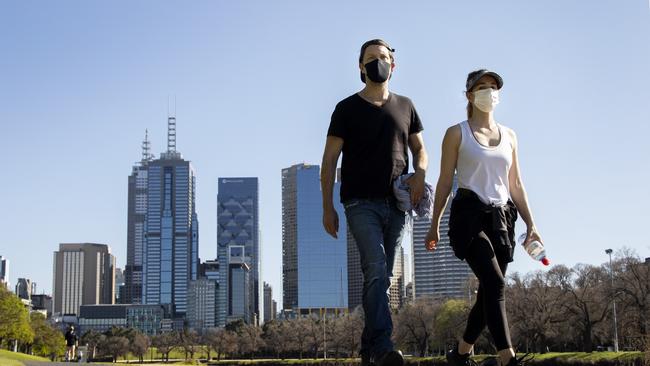
“Part of the problem … is when you believe, to the best of your judgment, to the best of the advice, that you had it beaten, only to then find clearly we hadn’t, you have to learn from that,” he said.
It came after Professor Sutton admitted the state’s system buckled as case numbers spiked during the second wave.
“It’s pretty clear that the numbers got beyond Victoria’s capacity to deal with every case in a timely way,” he told 3AW.
“The system that we had, we didn’t know what would be required. We didn’t know that we would get to 700 cases a day, and we didn’t know the particular weakness of our existing database.”
It emerged on Tuesday the government had in March knocked back an offer to use digital contact-tracing technology to boost tracing efforts, as it now rolls out the program.
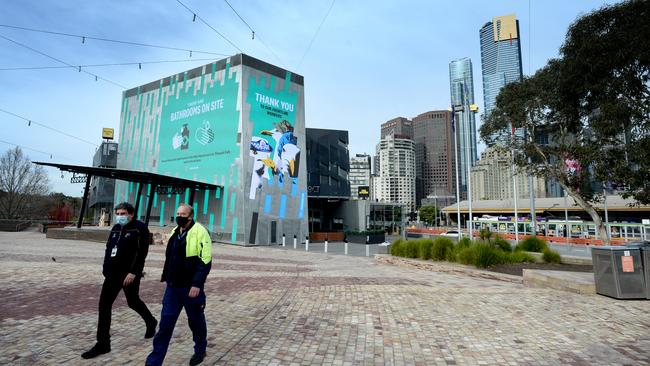
Prof Sutton conceded that some GPs were still using faxes to flag new coronavirus cases.
Mr Andrews tried to downplay the significance of the trip to Sydney, saying it was simply to “double-check and triple-check whether there is anything that is different between our response and the response of NSW”.
“It may not necessarily be found that there is much that’s very different at all, but because New South Wales is dealing with a very small number of cases that’s a different challenge to dealing with hundreds of thousands, so they may have some insights in what we can expect to confront — not right now, but in a few weeks time,” he said.
In August, Victoria had a two-week daily average of 219 cases, including hundreds of mystery cases, while NSW had just 13.
Mr Andrews declined to answer questions about whether Victoria had previously had sufficient contact-tracing resources, even in July after the team was expanded up to 2100 workers.
He said “as the task grows the team needs to grow and that’s exactly what’s happened”.
Government and department sources have repeatedly sounded the alarm over Victoria’s poor contact tracing, saying it was the reason outbreaks from hotel quarantine had been allowed to spread.
Mr Andrews himself in August admitted a “significant” number of cases had originated from the hotels.
Deputy Chief Medical Officer Nick Coatsworth said Victoria’s contact tracing had quickened over the past few weeks, in part due to movements away from paper to digital systems.
“The focus of the Victorian public health unit is to examine that entirety of the contact tracing, the public health response from testing through to concluding the contact- tracing interview and to make those as efficient,” Dr Coatsworth said.
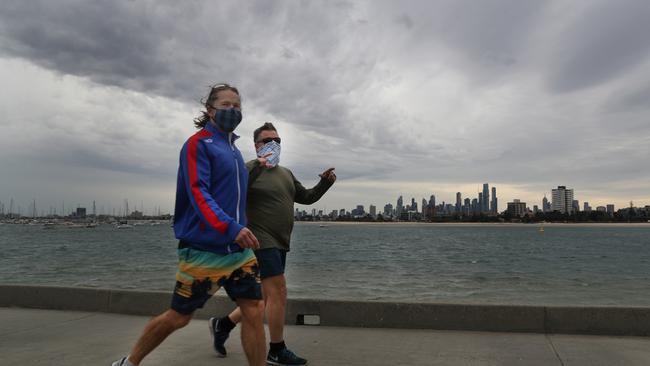
“If you have got a paper-based system there are certain efficiencies you will get from digitalising those.
“Chief Scientist Alan Finkel has been working closely alongside colleagues within DHHS to ensure when a process can be digitalised, it is.”
The Herald Sun understands text message systems will be implemented as part of the state’s contact-tracing changes.
The federal government is still waiting to receive Victorian modelling on the road map to reopening, and assumptions underpinning it, days after it was announced.
Dr Coatsworth said he was confident Victorian authorities would reconsider some of the high thresholds for reopening if tracing could be improved. “Officials are more than prepared to look at timelines and revisit them,” he said.
— Alex White, Tamsin Rose
COLAC RESIDENTS TAKE OUTBREAK CONTROL INTO OWN HANDS
Community leaders in Colac have relied on the “bush telegraph” to crack down on two separate outbreaks after ongoing frustrations with government delays.
After an initial cluster linked to the local meatworks, the town has been hit by a second outbreak of 25 cases believed to be linked to just one or two infected residents.
Polwarth MP Richard Riordan said in both instances the community had led the way with their own contact tracing, rather than waiting on the Department of Health and Human Services before acting.
He said once infections were identified, business leaders and other groups had immediately sent people home from work and begun taking extra precautions.
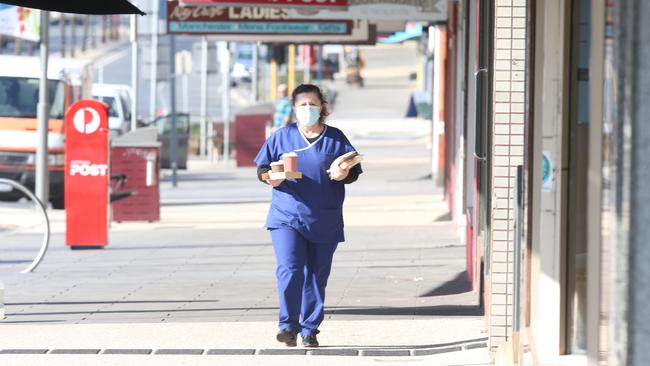
“In one instance we had a husband tested Monday and notified Wednesday while his wife was tested Wednesday and notified at 5pm Friday,” he said.
“If the employers had not used common sense and sent them home immediately there would’ve been a whole week of spread at those businesses.”
Mr Riordan said the department needed a formal system that worked at a grassroots level.
“The only reason Colac didn’t blow out is because people have been sharing unofficially,” he said.
“The bush telegraph and the Keep Colac Safe Committee show local information doesn’t need to be kept secret.
“If you empower a community and let them know where a disease is you can work together.
“This secrecy the government insists on isn’t working.”
But Jeroen Weimar, the newly appointed DHHS deputy secretary for community engagement and testing, on Tuesday said the department had been working over the past month to create more localised efforts outside Melbourne.
CONTACT TRACING DAYS BEHIND, INQUIRY HEARS
Alfred Health took control of contact tracing for staff potentially exposed to coronavirus amid concerns health department disease detectives were days behind.
Alfred Health’s chief operating officer Simone Alexander told the state’s hotel quarantine inquiry it retained responsibility for its own staff. Staff have been deployed in the hotels to care for those being quarantined.
“They were our employees and we wanted to look after them with regards to this (contact tracing) and other aspects,’’ she said. “It was sometime in late May … there was a contact trace in progress (with) significant differences identified.’’
Ms Alexander said the differences between the Department of Health and Human Services and Alfred contact tracers related to “time frames … and conflicting information”.
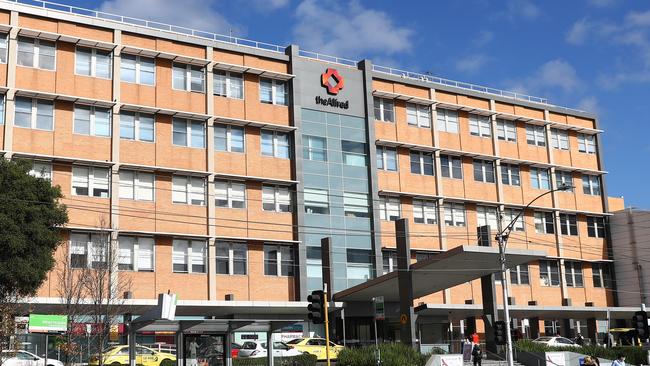
“Some staff were not contacted (by the DHHS) for a number of days,’’ she told counsel assisting the inquiry Ben Ihle. Ms Alexander agreed with Mr Ihle that after concerns were raised with the DHHS, Alfred Health was invited to see how it could expand its contact tracing beyond its own workforce, and later took on tracing for all involved on site, including Victoria Police. Alfred Health now manages the program to quarantine health workers and other vulnerable people in Melbourne hotels if they can’t quarantine safely at home, or have tested positive to COVID-19. No staff have contracted COVID-19 from guests under the program being run by Alfred Health.
Inquiry chairwoman Jennifer Coate confirmed there was a “difference of days’’ between when individuals were contacted about possible exposure.
Ms Alexander agreed, and said there was conflicting information given about how long staff needed to remain off work after being notified of a possible exposure, and when to get tested.
— Ellen Whinnett
HOPES TO EASE RESTRICTIONS SOONER
Victoria could reopen earlier than the state’s controversial road map has forecast with Daniel Andrews promising to lift restrictions if case numbers drop.
The Premier on Tuesday provided a small window of hope to Victorians in lockdown by confirming the dates outlined in the state’s road map to recovery were not set in stone.
When the plan was announced on Sunday, the state government said modelling showed reopening too soon would spark another wave of cases and restrictions.
“If we are making progress earlier than we otherwise thought we would, that’s all good,” Mr Andrews said.
“This is not a static thing, it’s not like it’s been run and now that’s the only model.
“The model will continue to evolve.
“It’s about trying to predict to a high degree of scientific and mathematical certainty, but not complete certainty.”
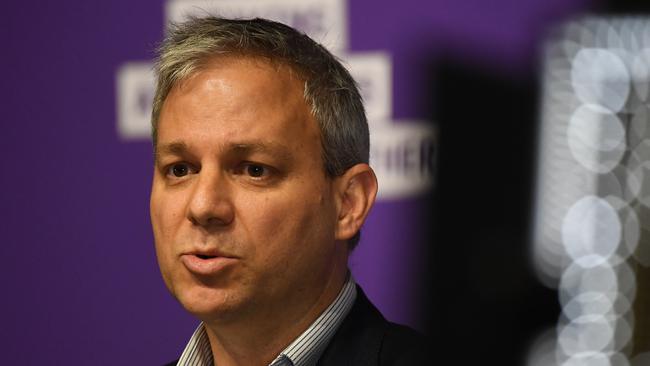
The road map dictates Melbourne won’t move to its “third step” — when hospitality venues can reopen to limited patrons and students from years 3 to 10 return to school — until the average daily cases dropped below five.
And the next step of easing restrictions would only happen once the state recorded 14 days without any new cases.
After the intense backlash, Chief Health Officer Brett Sutton suggested lockdowns could be eased without meeting the strict guidelines, but only if remaining cases could be traced and contained.
He said the benchmarks set were achievable but targets would be considered with some flexibility.
“We always reserve the right to have a look at what those cases are,” he said.
“If it’s at 10 cases per day but eight of them are in aged care and contained, I think we can review with that in mind.
Data shows neither NSW or Queensland have gone a fortnight without any new cases since the pandemic hit.
— Alex White and Kieran Rooney
RELATED:
YOUR RESTRICTION QUESTIONS ANSWERED
ARE CASE TARGETS ON TRACK TO EASE RESTRICTIONS?
BUSINESSES SLAM ANDREWS’ PLAN TO EASE RESTRICTIONS
WHAT EVERY STEP OUT OF RESTRICTIONS LOOKS LIKE FOR BUSINESSES
